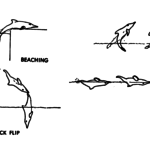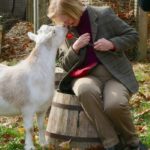In 1978 the government, the environmentalists, the fishery and the industry jointly established a year-long at-sea research program. They named it the Year of the Dedicated Vessel.
A single skilled American tuna fishing seiner would be hired to make several voyages into the Pacific, carrying six scientists per trip. They would travel out to the area where tuna and porpoise abound, 1000 miles from land and in water thousands of feet deep. The researchers would look at everything from net design to tuna behavior. I was happy that the program was put in action. In meetings and on the phone and when giving talks I was a strong supporter of the concept.
I never even considered the possibility of going, myself; the experts chosen for the Dedicated Vessel trips were all male, all with Ph.Ds, all well known. I was none of these things. I was a good consultant and getting quite a lot done for the tuna industry and the fisheries; but I did not expect to be shipping out on the DV vessel. However, one morning in my New York apartment I got a phone call from someone at the National Marine Fisheries Service (generally referred to as NMFS, pronounced ‘nymphs’). They had an unexpected opening on the Dedicated Vessel trip coming up. Would I like to go out on that vessel, the Queen Mary, and study the behavior of the dolphins?
You bet I would! So after a certain amount of complicated quizzing by some woman in the National Marine Fisheries Service I was told I was acceptable. I would be the principal investigator for studying the dolphins. AND I could take one other person with me, too. Wow. Good thing nobody else was home. I danced around the living room, singing “I get to go, I get to go” and jumping up and down.
Then I called Ingrid. Ingrid Kang is a Swedish biologist who came to Sea Life Park one day looking for a job. We met and ate lunch together. I hired her instantly. She quickly picked up the new kind of training and soon became an expert. Ingrid was ingenious with the animals and skilled with the trainers, too. When I finally left Sea Life Park Ingrid took over the training facility. I missed Ingrid; we had become close friends.
So here was a great chance for some time together. I called Ingrid. I explained the Dedicated Vessel program and the several weeks we would spend at sea. At Sea Life Park Ingrid and I and the training staff had worked with nine different species of dolphins. On this trip Ingrid and I would focus solely on the two species that associate with tuna fishes: the gray and white spinner dolphins, Stenella longirostris, with their strange habit of whirling in the air, and spotted dolphins, Stenella attenuata, with their dramatic speckled markings and their ability to make very high jumps.
I called Ingrid and asked, “Do you think Sea Life Park would give you time off to make this trip?”
“I don’t know,” Ingrid said, “but it doesn’t matter. Wherever you go, I will go.”
The trip was on and we were both ready. Ingrid flew from Hawaii to San Diego. I flew from New York to San Diego. Some tuna industry people picked us up from the airport and installed us in a hotel. We had been assigned to arrive two days a before the trip started (good, we could de-jetlag). We were scheduled for an NMFS briefing ahead of the trip. We were also told that we would be required to take a swimming test. Not a problem for us; we had both spent our lifetimes in and out of the water.
The next morning some staff people picked us up at our hotel and drove us to a large outdoor swimming pool. We changed into bathing suits. We swam from one end of the pool to the other, and back. And then again. And again. Now and then we floated together in the middle of the pool to chat for a while. I don’t remember how far we were supposed to swim, a mile, perhaps. Anyway we didn’t bother to keep track. Eventually we were told we’d done enough and could get out.
That afternoon I found a liquor store and bought a couple of bottles of inexpensive screw-top wine. We were not really supposed to bring liquor aboard, but I thought a little wine might be a comfort at sea. I wrapped the wine bottles in clothing and packed them at opposite ends of my duffle bag so they wouldn’t give us away by clinking together.
The next morning was departure day. We would be driven to the docks where our ship, the 180 ft. Queen Mary, was waiting. A large and rather self-important government official met me in the hotel lobby and took me and my duffle bag to his car. Ingrid meanwhile was delivered to the ship by some other vehicle. Why we didn’t go together? I found out as soon as I got in the car. The official who would drive me was going to use the time to tell me about all the serious problems Ingrid and I would face once we were aboard the ship.
My driver told me that women are not welcome on shipboard. A woman may make trouble among the men, or she may be picked on and mistreated. He said that the people who objected most about having women aboard were the crew’s wives. They were worried that Ingrid and I would seduce their husbands.
However, a solution had been found. Ralph, the skipper, a kind and sensible man in his forties, would be bringing his wife Evelyn with him. Evelyn would chaperone me and Ingrid, making sure we didn’t fool around inappropriately. I startled my driver by laughing. Ingrid and I were in our mid-forties, the mothers of grown children, and not likely to chase after the mostly very young crew!
The driver went on educating me. He said that no matter what, we should be prepared to be very unwelcome. He explained that the crew, though mostly American-born, were a close-knit clan largely of Portuguese descent. They were known to be conservative, short-tempered, and easily offended. Scientists were respected on the ships, but I had heard that some observers on other fishing voyages had been hazed and picked on.
I thought about my travel the previous year aboard the David Starr Jordan. That crew, all Americans and all government employees, amused themselves aboard that government vessel by ridiculing and criticizing me and Nancy Lo, my statistician roommate, at every meal and whenever crew were off duty.
That government research vessel trip had been hard for me and Nancy. But I had assumed the real fishing ships were much better organized. I had come to know some of the skippers at various meetings and found them to be wise, kind, and interesting. I hadn’t been a bit worried.
But now the government official that drove me to the dock had painted a different picture, and I was thoroughly upset.
The car reached the dock at last. Ingrid arrived too, in another car. My driver parked at the dock and unloaded my gear. Our duffles were carried off by crew. Ingrid and I walked down the dock toward the Queen Mary. I had a strange sensation in my stomach. When had I ever had that feeling before? It came back to me: being wheeled into an operating room to deliver my first baby via Caesarean section. The feeling on that hospital gurney was the feeling I was having right now: dread.
We were escorted aboard the ship. The wives and families had been gathered in the main lounge of the ship. Now they went ashore. Goodbye, goodbye. Sad partings. The engines started. The Queen Mary began moving sedately out of the harbor.
After we’d left the dock, when everyone including us was moping around in the lounge (leaving home and the land is always a gloomy moment) the captain gathered up Ingrid and me and took us to meet the cook. He showed us a list on the galley wall: the dishwashing roster. We put our names on the list. It’s nice to have useful ways to keep busy on shipboard, and we certainly knew how to wash dishes.
The fishermen were watching. Everyone saw us sign onto the dishwashing list. The captain’s son, Ralph Jr. who at 21 was first mate, and his best friend Bobbie, the 19-year-old navigator, told us later that some of the scientists on previous trips had refused to wash dishes. Signing that list was our first good move.
Captain Ralph took us up to our new quarters on the top deck. Ralph and Evelyn shared a comfortable room on the port side. The bunkroom Ingrid and I were using was on the starboard side, with a shared bathroom between the quarters of the captain and his wife and our quarters.
Now two crew members showed up with our duffle bags, set them down on the floor, and left. Ingrid raised an eyebrow and said “Clink.” Oops. However we didn’t hear anything about it, then or later, and the wine would come in handy if we were in the water long enough to get chilled.
Meanwhile, on our first evening, Ralph and Evelyn invited us to sit with them in the lounge and chat. Ralph explained that the rule was you could have only one drink before dinner, but you could make it as large as you liked. I poured myself a generous scotch on the rocks. Ingrid I think drank soda. We had steak for dinner at a long table with all the crew. We retired early, lulled by the gently rolling ship, and enjoyed a good night’s sleep.
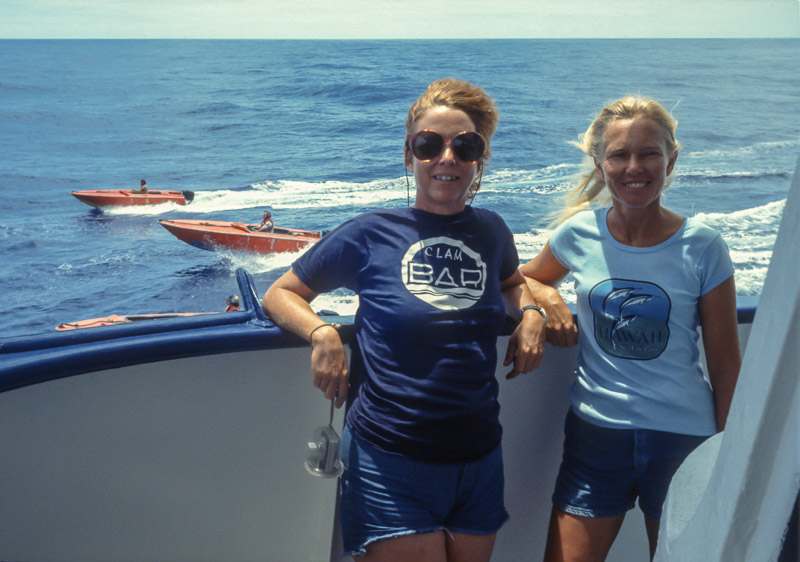
Ingrid and I still had many things to learn. We went around the ship barefoot the next morning. The skipper stopped us and said we needed to put shoes on. I protested that in Hawaii we go barefoot all the time. “That’s not it,” Ralph said. “The cables that bring in the nets are made of fine wires. Tiny slivers of wire break off. They get all over the ship, we can’t help that. And they’ll work their way into your skin. It hurts like hell and its hard to get them out.”
Oh. OK. We hurried back to our cabin, dusted our feet off, and put on sneakers. Then we spread out in the lounge and prepared our gear. Back in New York, my friend Jon Lindbergh had told me you could easily write underwater if you had the right gear: Plexiglas writing tablets, and pencils with good black leads.
I had located a plastics store in New York and commissioned fifty tablets to be made. The tablets were the same size as ordinary typing paper, with two holes drilled in the top for a string to hang the tablets around our necks, and a separate hole to for tying the pencils to each tablet. I had them painted white on the backs so the writing would show up. I also brought ten boxes of drawing pencils with dark leads that made a good line. Why so many? Because I knew we were going to lose some. And all our scientific data depended on those underwater writing tools.
I had brought rolls of strong string with me, but Ralph pointed out that the tarred cord that the nets were made of was much better; and he gave us a supply. Hurray and thank you, Ralph. We used ship’s cord to tie a pencil to every tablet and made a loop for each one so we could hang them around our necks and keep our hands free when needed.
On the day before we left, we met with NMFS scientists for instructions regarding research. In early years, before the nets were made more manageable, many dolphins drowned. An annual mortality rate might be 100,000 animals. Or more. Improvements for the net design and management had reduced mortality tremendously over the years; nowadays one might have a whole fishing trip, with many sets, in which almost all the dolphins in the nets were released without harm.
But still, the population was not bouncing back. What was the problem? The NMFS scientists speculated that the animals were actually dying from fright; not in the nets, but afterwards. There was evidence of this in antelopes, for example, having a bad scare and then dying of shock and fear the next day. On our trip, the official main question was going to be describing fear behavior. We would of course record fear behavior if we saw some and we would later write it up as part of a monograph for the government; but meanwhile we would be collecting data on everything else: all the behavior we saw and whatever else happened that interested us.
Our ship would travel about four days to get to the fishing zone. Ingrid and I would be going into the nets in a small inflatable rubber boat called an Avon. We would take slates, pens, sunglasses, facemasks, snorkels, and flippers.
Ralph said we were welcome to use the tables in the lounge between meals. Ingrid and I went to work. First we took over one of the dinner tables and made an ethogram, a chart of the animals’ behavior. We based it on our fifteen or more years of personal experience with many spotters and spinners in captivity. Together we drew up a list of every behavior we knew of, from taking a breath to diving to spinning in the air, to gaping the jaws (a threat), to what Ingrid had dubbed snitting, a spotter dolphin display of shaking the open jaws up and down while making disagreeable noises (also a threat.) When we’d made our chart we had 85 separate behaviors.
We had a new plan for observations. We were going to study the dolphins using a system from the University of Chicago called Focal Animal Sampling, a handy process when you are looking at a large group of animals, a herd of antelopes for example. A Washington Zoo expert had told me about it and how to do it. You pick one animal to watch. You watch it and write down what it’s doing during a specific amount of time. Then you pick another animal and watch it for the same length of time, and then another, and so on.
It was a great idea, actually. Field scientists, however skilled, tend to watch events and movement, two male antelopes fighting each other, for instance. That’s what catches the eye. A single female or even ten females just hanging around doing nothing in particular is not that interesting. Consequently the observations that show up in the resulting publications might not be as complete as they should be. The observations may focus on the drama in an animal group, and think about dominance as an important event; how about the 99% of the herd or group that is cooperative and calm? That’s important too!
We spread out some typing paper to make a list of things on our ethogram. We chose a two-letter code for each behavior, such as BR for breathe, DV for dive, SP for spin in the air (it’s a spinner behavior, spotters don’t do that). By holding the slate in one hand and putting one’s writing hand against the other edge of the slate you could jot down the code for a behavior, then move your hand a bit lower and jot down another, without taking your eyes off your focal animal.
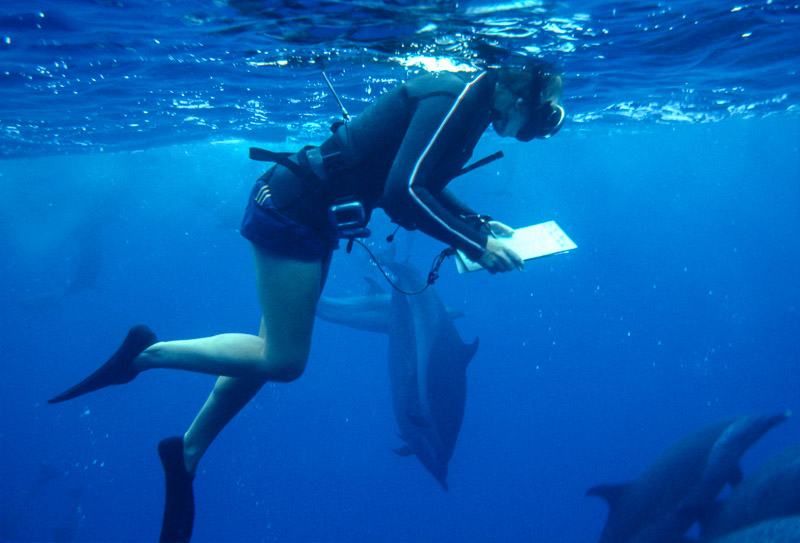
I chose five minutes as the length of time for each sampling. We’d use one slate for each sample, toss it into the rubber Avon after five minutes, and then start again with another slate and another dolphin. We had no idea how many samples we could take, or even if we could take any. Perhaps there wouldn’t be enough visibility. Perhaps the animals would keep moving. Perhaps they wouldn’t let us come near enough to distinguish individuals. Perhaps we’d end up lying in our bunks reading mysteries too! But if the work could be done at all, we’d be prepared.
We were not the only scientists on the ship. A fellow named David from the National Marine Fisheries Service was the official leader of six researchers. David was one; Ingrid and I were two more. Then came Walter, from the University of Hawaii, and his student assistant. They were studying the behavior of the tuna in the nets. The sixth member of the group was Philippe Vergne, a young marine biologist Frank Alverson had sent along to look after me and Ingrid.
The weather was mild and we were travelling further and further out to sea. Right after lunch Dave instructed Ingrid and me to go to the top deck for a private meeting. I wondered what’s that about? Ralphie the first mate and Bobby the navigator joined us. Dave joined us. We all sat down together on the deck.
Dave said he was sorry to say he had some bad news. Ingrid and I could both go into the net in the Avon; but Ingrid would not be allowed to go in the water.
“What do you mean?” I said.
“Ingrid failed to accomplish a requirement,” he said. “You must complete your physical examination. But you did not take your Electrocardiogram: your EKG.”
“I never heard of that,” Ingrid said.
“But I sent you a letter!” Dave said.
“Oh, a letter…” Ingrid said, with faint disdain. If it wasn’t from Sweden she might not have read it. Anyway she hadn’t seen any letter.
Dave smirked. “Well, Ingrid, you will have to stay in the Avon. But you can lean over the edge and look through your mask, can’t you?”
“No she could not,” I said. “Ingrid will need to be able to see laterally as well as downward, to record data on the dolphins.”
Dave said, a little crossly, “She cannot be allowed to go in the water.”
“Well then,” I said, “we have to go back to San Diego and get her EKG.”
Ralphie the first mate got up, left the top deck, and returned one minute later with his father, Captain Ralph. The skipper sat down and listened to the problem. Then he turned to Ingrid. “Are you perfectly healthy?”
“As far as I know,” Ingrid said.
“Well, I think we’ll take the chance that Ingrid can go in the water. If she drowns or something, I’ll be in serious trouble, you know.” Silence all around.
“Thank you,” I said.
The captain stood up and left. Bobby and Ralphie were gazing into space, trying not to laugh. Dave, the official group leader, silently gathered up some papers he had brought along and went below.
Ingrid and I still had things to learn. I was straightening up the cabin and as I left, the ship rolled to the left (port side.) The door swung open. I went through. The ship rolled the other way. The door slammed shut behind me. It was a simple phenomenon that I sort of enjoyed. However, just then the captain appeared from his cabin and said “Let me show you how to close a door.”
He demonstrated. “Go out the cabin door. Reach back and catch the handle in one hand. Close the door gently behind you. You have been letting the door slam shut by itself; but it is not a good thing.”
He explained. The ship’s engineer, a graying, taciturn person we saw only at meals, always took the night watch. He slept during the days. My slamming door had been waking him up. And if there is one thing the man in charge of the ship’s huge engines doesn’t like to hear, it’s an unexplained bang.
I explained this to Ingrid and showed her how to close a door. From then on we were both very careful to close our cabin door silently. A few nights later, as I sat down to dinner the engineer sat down next to me. He always bought a personal bottle of pepper sauce to meals. He never shared it. Now he passed his bottle to me and said, “Try some of this; my wife makes it.”
Nineteen pairs of fishermen’s eyes swiveled toward this interesting scene. I sprinkled some of the engineer’s sauce on my steak. I ate a bite and told the engineer the sauce is excellent. He nodded and took the bottle back. I’d been rewarded for learning not to slam doors.
On the next morning Ingrid and I woke up and realized the engines had stopped. We threw some clothes on and went out on the deck to see what was going on. It was a glorious day. The sea was almost flat calm; there was no wind. Two small islands stuck up out of the sea in the distance. The sky was brilliant blue, dotted here and there with puffy little white clouds. The net boat was in the water and had laid down the net in a big circle. And in the net we saw an occasional dorsal fin breaking the surface. Dolphins!
Ingrid and I hurried back to the cabin and put on bathing suits under our tee shirts and shorts. The little rubber Avon raft was inflated and ready on the deck. We put our slates, fins, masks, and snorkels into the Avon. As the crew lowered the raft over the side, Ingrid and I climbed down the wet and slippery steel rungs of the ladder built into the hull.
We stepped carefully into the little Avon and picked up the two little paddles we’d been given to use. Crew members dropped the Avon’s rope into the boat with us. Thrilled and excited we paddled around the stern of the ship, over the top rim of the net. At first we paddled along the side of the ship, within the net. Not a good idea; the ship rolled a little, and we were close enough so I thought we might get pushed under. Paddle fast! We headed out into the middle of the net. We put the paddles in the Avon, put on our fins, masks, and snorkels, hung our pencils and slates from our necks, and slid quietly into the water.
The water was so clear! (My father Phil described it as gin-clear water, and people still borrow the metaphor for their own books.) I could see all the dolphins, as conspicuous as horses in a field. The water was warm, too, you could stay in it for hours. And when we slowly, tactfully, drifted alongside the dolphins they didn’t seem to mind at all.
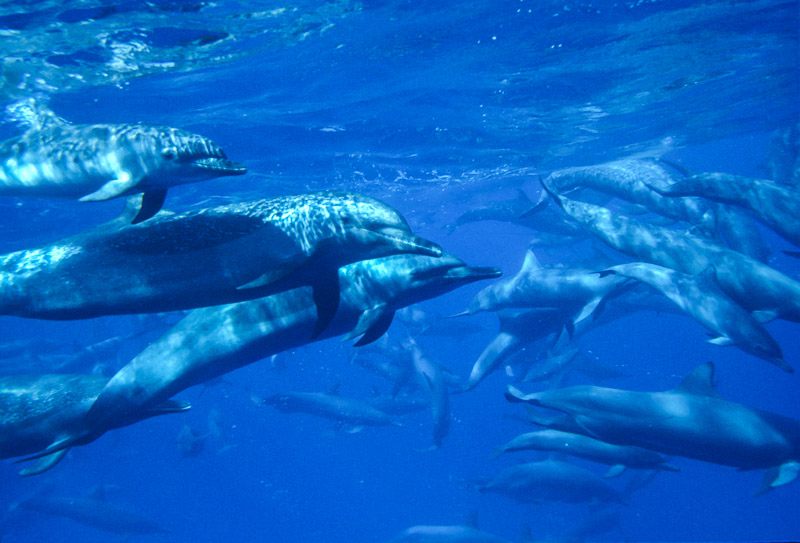
This small school consisted of 23 spotted dolphins, of mixed sizes. A few were diving slowly straight down and coming straight back up, over and over, in a pattern Ingrid dubbed columning. Mothers and babies were playing together. Little groups of three or four animals circled the column at various depths. Ingrid and I grabbed tablets, looked at our watches, and started taking Focal Animal Samples. The calm animals and the marvelous visibility made it easy. This was going to work.
A famous scientist has said that to really understand wild animals. you need thousand-hour eyeballs. That night I counted up the years I had spent at Sea Life Park and calculated that Ingrid and I had 10,000 hours of watching our many kinds of dolphins in captivity. We could read them pretty well. The 23 animals we were watching now, both at the surface and under the water, were definitely not in a panic, or even upset.
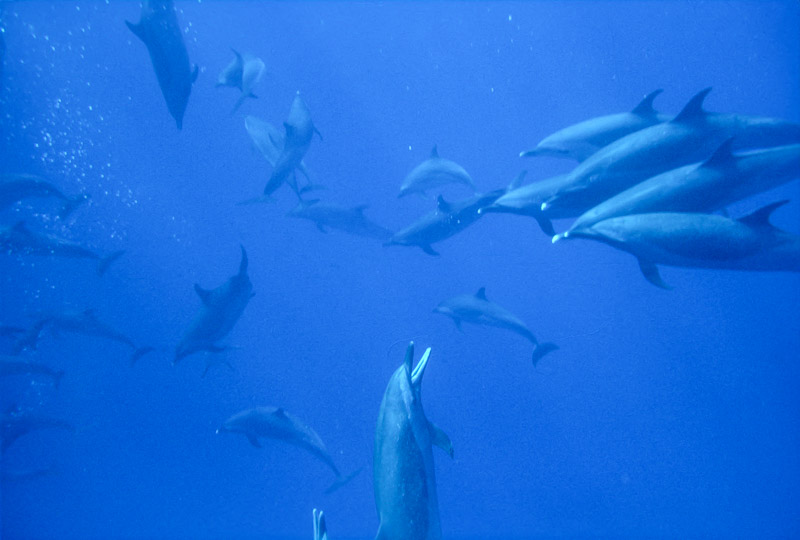
I paused for a moment and took a look across the surface. Below me in the net the turquoise water darkened, down, down, down into an impenetrable indigo. I could see Ingrid, nearby, floating face down with her snorkel sticking up into the air. Beyond her, dorsal fins lazily rolled as animals surfaced quietly to breathe and then went under again. On the far side of the net the Queen Mary’s white sides gleamed in the sunlight. I could make out Chapo, the cook, leaning on the railing, watching us. From now on, watching me and Ingrid would be Chapo’s job whenever we were in the nets. And we would be back in the nets over and over, on this trip. I was bursting with joy.
Ralph signaled the crew to start drawing the net back aboard. When an appropriate amount of net had been brought aboard the engines started and the ship began to go backwards, dragging the remaining portion of the net into a long oval, and sinking the far rim of the net so that the dolphins could swim over it and leave.
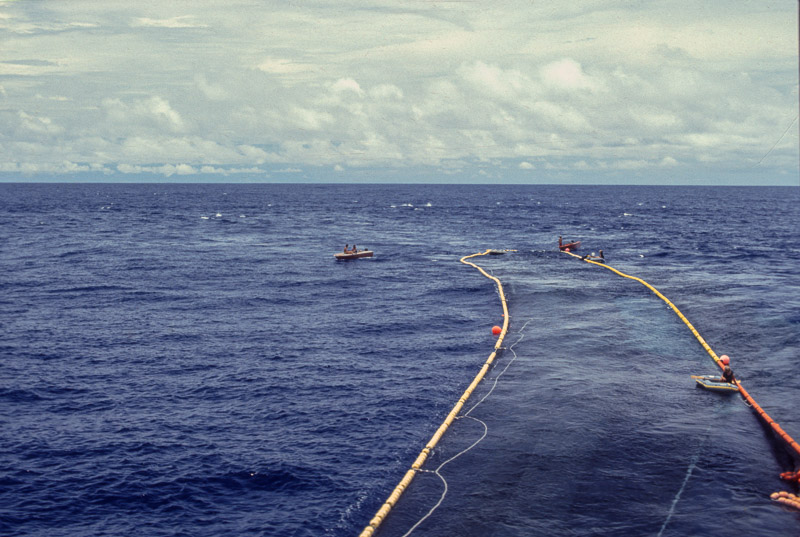
I realized that in fact the skipper had planned this event deliberately. The two barren little islands in the distance were well known to Captain Ralph. He knew that spotted dolphins were frequent residents around those islands. This serene day was a good time for a practice run. The net would be set around a few dolphins, the boat would be idle, and Ralph was getting a good look at how Ingrid and I were behaving in the net.
Meanwhile Ingrid and I paddled back, around the stern of the ship, and went up the ladder. The Avon was lifted aboard with a crane. Ingrid and I went up to our cabin and got into some dry clothes. In the lounge Skipper Ralph cocked his head at us. Come on over. We sat down with him in the lounge to get our report.
I think he was satisfied with our general skills and efficiency and our tact around the animals. But Ralph had a few requests. First, if it did happen that sharks were in the net somewhere, the white backs of the tablets would be very visible and flashy, just the kind of thing that attracts sharks. Ralph would provide us with black paint so we could cover the backs of the tablets. Not a problem, we could easily do that. However, though we had tee shirts and shorts on over our bathing suits, our arms and legs were pale and white and would show up very clearly in the water. That could also attract sharks. Ralph asked us to wear jeans and long sleeved shirts over our bathing suits in the water from now on. Okay, no problem.
What we didn’t know yet was that we would be finding out more and more about the dolphins, especially the spotters: more than we could have imagined. We were going to have a total of 17 dives in the net, and additional watching from the deck, too. We had adventures ahead. And of course we liked the dolphins, and they, amazingly enough, sort of liked us too. At least they accepted us; perhaps they found us strange but tolerable other kinds of creatures in the water.

